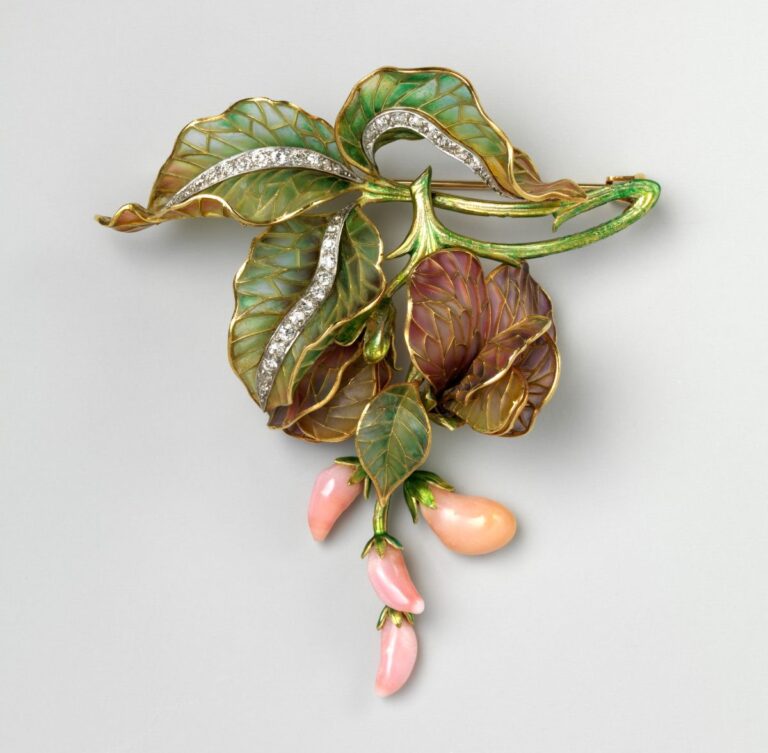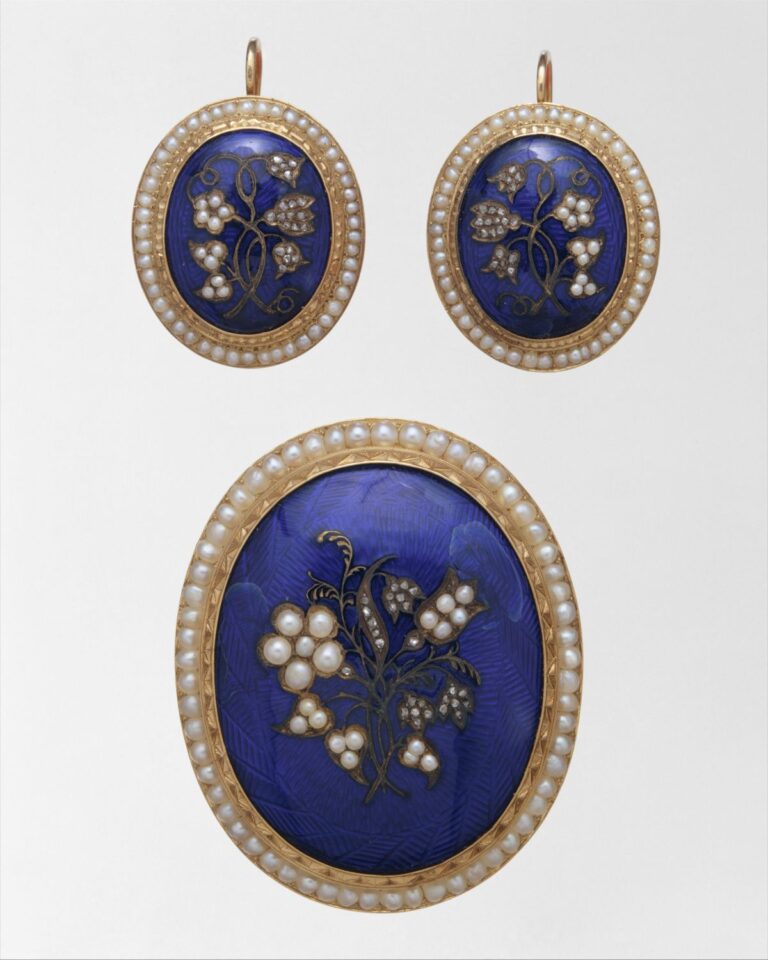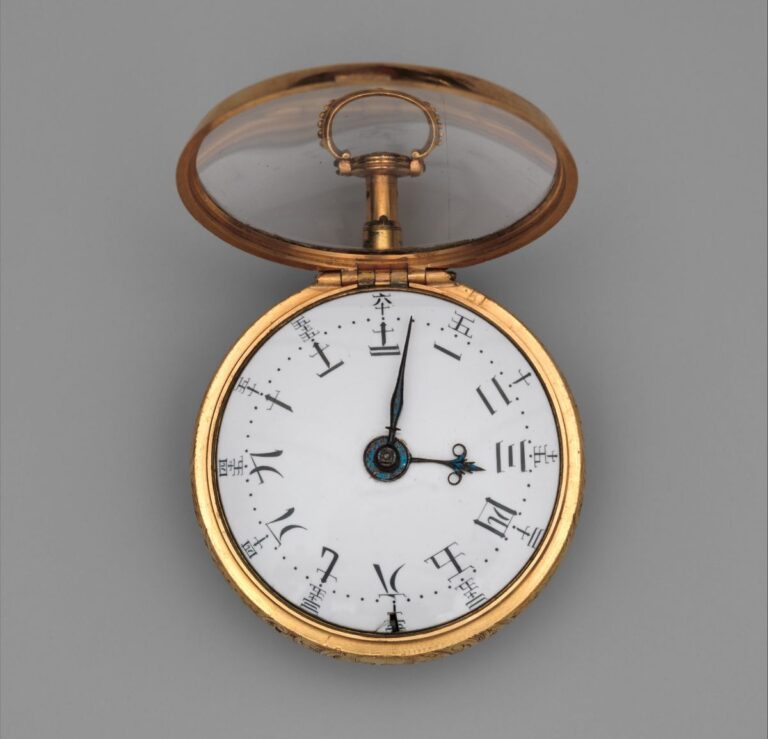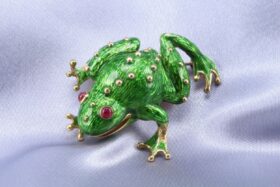
18 Mar Antique Enamel Jewelry: A History of Elegance
Seen above: Recently acquired by C. Blackburn Jewelers, a “memento mori” ring with white enameling from 1752.
Antique enamel jewelry is celebrated for its timeless beauty. Each piece is a work of art, crafted with intricate details and often vibrant colors. From delicate enamel pendants and earrings to exquisite enamel rings and bracelets, this fine jewelry has a history of elegance like no other — which is why at C. Blackburn Jewelers, we always are excited to talk with customers about these pieces.
If you are looking to sell antique enamel jewelry in San Diego, you can get started right now by contacting C. Blackburn Jewelers in La Jolla. We also buy pieces from out of state customers, as well.
For those who want to learn more about enamel jewelry, let’s dive deep into the topic, so that you can gain greater appreciation of these items.
History of Enamel Jewelry
The earliest evidence of enamel can be traced back to ancient Egypt, where it was used to decorate precious objects such as amulets and jewelry. The Egyptians developed a technique known as cloisonné, where thin strips of metal were used to create compartments that were then filled with colored enamel.
In China, enamel work dates back to the Shang Dynasty, around 1600-1046 BC. Chinese artisans perfected the art of cloisonné, creating intricate designs that adorned everything from ornaments to vases. They also developed the technique of painted enamel, where enamel was directly applied to the metal surface, allowing for more detailed and realistic designs.
Enamel jewelry gained popularity in Europe during the Middle Ages. It was particularly favored by the Byzantine Empire and the Eastern Orthodox Church, where enamel was used to create religious icons and ornate crosses.
The Renaissance period saw a resurgence in enamel jewelry, with artists like Benvenuto Cellini creating masterpieces that showcased the beauty and versatility of the medium.

Characteristics of Antique Enamel Jewelry
Antique enamel jewelry is known for its unique characteristics that set it apart from other forms of jewelry. One of the most notable features is the vibrant and enduring colors of the enamel. Unlike gemstones, which can lose their luster over time, high quality enamel can retain its brilliance and beauty for centuries.
Another characteristic of antique enamel jewelry is its durability. The enamel is fused with the metal surface through a process of high-temperature firing, creating a strong bond that ensures the longevity of the piece. This durability is one of the reasons why antique enamel jewelry has survived through the ages and often remains in pristine condition.
Antique enamel jewelry also showcases exquisite craftsmanship. The intricate designs and attention to detail are a testament to the skill and artistry of the artisans who created these pieces. From delicate floral motifs to elaborate scenes, every enamel jewelry piece tells a story and reflects the artistic sensibilities of its time.
Types of Enamel Techniques Used in Antique Jewelry
There are several enamel techniques that have been used in the creation of antique jewelry. Each technique offers a unique effect and allows for different artistic expressions. Some of the most common enamel techniques used in antique jewelry include:
1. Cloisonné: This technique involves creating compartments using thin metal strips (cloisons) and filling them with colored enamel. The result is a mosaic-like effect with clearly defined shapes and lines.
2. Champlevé: In this technique, the metal surface is engraved or etched to create recessed areas, which are then filled with enamel. The excess enamel is then polished away, leaving a smooth and even surface.
3. Plique-à-jour: This technique creates a stained-glass effect by using transparent enamel that is applied between thin metal wires. When held up to the light, the enamel appears to glow, creating a mesmerizing effect.
4. Basse-taille: This technique involves engraving a design on the metal surface and then applying translucent enamel over it. The engraving adds depth and texture to the enamel, creating a visually stunning effect.
5. Limoges: Limoges enamel is known for its vibrant colors and intricate details. It is created by applying multiple layers of enamel, each fired separately, to achieve a rich and layered effect.

Popular Eras and Styles of Antique Enamel Jewelry
Antique enamel jewelry has gone through various eras and styles, each reflecting the artistic trends and influences of its time. Some of the popular eras and styles of antique enamel jewelry include:
1. Renaissance: The Renaissance period saw a resurgence of interest in enamel jewelry. Pieces from this era often featured intricate designs, such as floral motifs, mythological scenes, and religious symbols. Artists like Benvenuto Cellini and Jean Toutin were renowned for their enamel work during this time.
2. Art Nouveau: In the late 19th and early 20th centuries, the Art Nouveau movement brought a new wave of creativity and innovation to enamel jewelry. Designs during this period were characterized by flowing lines, nature-inspired motifs, and a departure from traditional symmetrical patterns.
3. Arts and Crafts: The Arts and Crafts movement, which emerged in the late 19th century, emphasized traditional craftsmanship and the use of natural materials. Enamel jewelry from this period often featured simple yet elegant designs, with a focus on handcrafted details and the beauty of the materials.
4. Art Deco: The Art Deco period, which spanned the 1920s and 1930s, brought a sleek and geometric aesthetic to enamel jewelry. Designs during this time were characterized by bold colors, sharp lines, and a sense of modernity.

Famous Designers and Their Contributions to Enamel Jewelry
Throughout history, there have been many famous designers who have made significant contributions to the art of enamel jewelry. These designers have pushed the boundaries of the medium, creating innovative designs and techniques that have left a lasting impact. Some of the notable designers include:
1. René Lalique: René Lalique was a renowned French jewelry designer who played a crucial role in the development of Art Nouveau enamel jewelry. His designs often featured organic forms, such as flowers and insects, and he was known for his innovative use of materials and techniques.
2. Fabergé: The House of Fabergé, founded by Peter Carl Fabergé, is synonymous with exquisite enamel jewelry. Fabergé’s creations, including the famous Fabergé eggs, showcased the highest level of craftsmanship and attention to detail.
3. Charles Robert Ashbee: Charles Robert Ashbee was a leading figure in the Arts and Crafts movement. His enamel jewelry designs were characterized by their simplicity and elegance, often featuring natural motifs and handcrafted details.
4. Jean Schlumberger: Jean Schlumberger was a French jewelry designer who immigrated to the United States and worked for the renowned jewelry house, Tiffany & Co. His enamel jewelry creations were famous for their bold colors and whimsical designs, often inspired by nature and animals.
Notable Collections of Antique Enamel Jewelry
There are several famous examples and notable collections of antique enamel jewelry. These pieces not only showcase the beauty and craftsmanship of enamel jewelry but also provide a glimpse into the history and culture of their time. Some of the famous examples and collections include:
1. The Cheapside Hoard: Discovered in 1912 in London, the Cheapside Hoard is a collection of Elizabethan and Jacobean jewelry, including several pieces of enamel jewelry. The hoard provides a fascinating insight into the fashion and design trends of the time.
2. The Royal Collection: The Royal Collection, housed in the British Royal Family’s collection, includes numerous examples of antique enamel jewelry. These pieces, many of which are from the Renaissance and Art Nouveau periods, are a testament to the royal patronage of the arts.
3. The Gilbert Collection: The Gilbert Collection, now a part of the Victoria and Albert Museum in London, is renowned for its extensive collection of decorative arts. The collection includes a wide range of enamel jewelry, showcasing different styles and techniques from various eras.
4. The Walters Art Museum: The Walters Art Museum in Baltimore, Maryland, houses an impressive collection of antique enamel jewelry. The collection includes pieces from different cultures and time periods, offering a comprehensive view of the art form.

How to Spot Fake Enamel Jewelry
As with any valuable collectible, there is a risk of encountering fake or reproduction enamel jewelry. So, if you plan on buying antique enamel jewelry or becoming a collector, it’s important to educate yourself about the different eras, styles, and techniques of enamel jewelry.
Also, be sure to purchase only from reputable sources like estate jeweler Carl Blackburn at C. Blackburn Jewelers in San Diego, or from an auction house like Christie’s which specializes in antique jewelry.
Here are some tips to help you spot fake enamel jewelry:
1. Research and Compare: Familiarize yourself with the characteristics and features of authentic enamel jewelry. Compare the piece in question to known examples or reference books to look for any discrepancies.
2. Check the Quality of the Enamel: Authentic enamel jewelry has a smooth and even surface with no bubbles, cracks, or discoloration. Look closely at the enamel to ensure its quality and craftsmanship.
3. Examine the Metalwork: The metalwork of authentic enamel jewelry is often of high quality, with precise detailing and a solid feel. Cheap or poorly made metalwork can be a sign of a fake piece.
4. Seek Professional Advice: If you are unsure about the authenticity of a piece, consult a professional jeweler or an expert in antique enamel jewelry. They can provide an expert opinion and help authenticate the piece.
How to Sell Antique Enamel Jewelry
The most common way of selling antique enamel jewelry is to visit an estate jewelry buyer. Many jewelry stores these days offer estate jewelry buying as a supplementary service to customers. But be careful.
It’s best to visit an estate jeweler who has deep experience in vintage and antique enamel jewelry, and who buys and sells these items regularly. This jeweler will be able to best evaluate how much your antique enamel jewelry in worth on the resale market, and provide you with a fair cash offer.
For example, Carl Blackburn at C. Blackburn Jewelers (La Jolla) is a 2nd generation estate jeweler who has been buying and selling enamel rings and fine jewelry for decades. He has the experience and expertise to accurately evaluate your enamel jewelry, and make you a cash offer that will be typically much higher than jewelers who don’t deal regularly in antique jewelry.
Carl will be happy to provide you with a complimentary market appraisal of your enamel jewelry. Just leave him a voice mail at 858-251-3006, or send an email via the contact form below. He will get back to you promptly.




